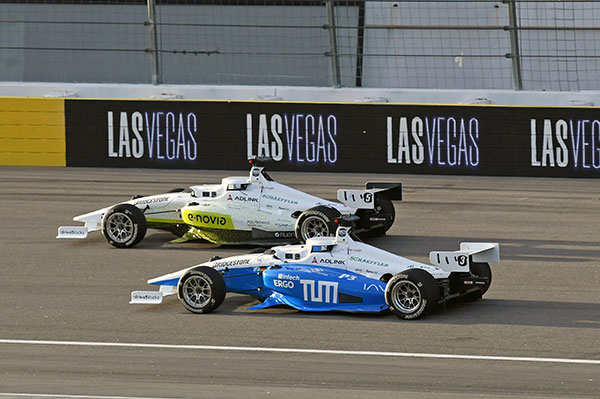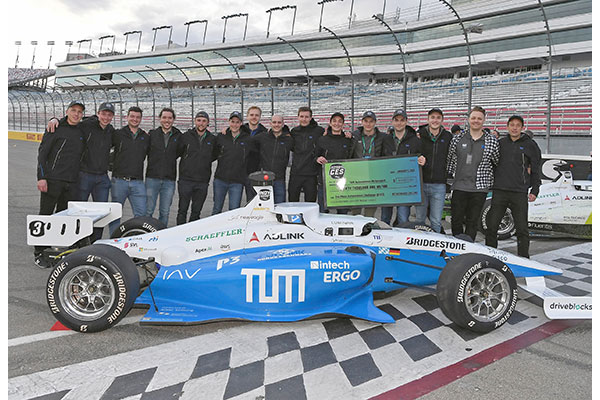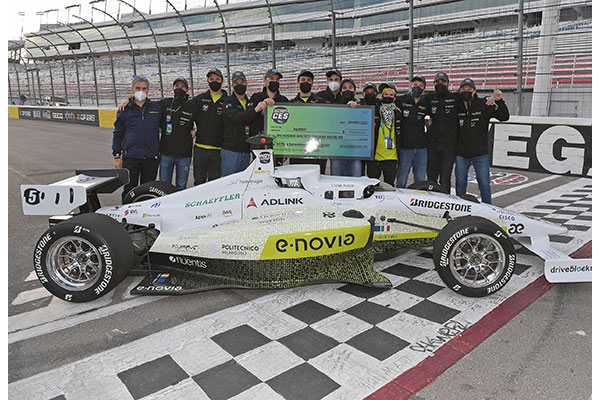
The PoliMOVE vehicle passes TUM in the final pass of competition at Las Vegas Motor Speedway. Images courtesy of IAC.
All vehicles are AV-21 race cars built by Dallara, an Italian race car manufacturer. The Indy Autonomous Challenge converts them to be autonomous by installing hardware and software on the vehicles. Images courtesy of IAC.
The Indy Autonomous Challenge organizes racing competitions among university-affiliated teams from around the world to program fully autonomous race cars and compete in a series of history-making events at iconic tracks. Images courtesy of Jim Romeo.
Latest News
February 22, 2023
The Indy Autonomous Challenge (IAC) organizes racing competitions among university-affiliated teams from around the world to program fully autonomous race cars and compete in a series of history-making events at iconic tracks. The most recent competition was held at the world-famous Texas Motor Speedway in November 2022. Teams competed at speeds topping 140 mph despite unseasonably cold and wet weather conditions with track temperatures dropping to near freezing—a testament to the innovative minds behind these vehicles.
Paul Mitchell serves as president and CEO of Energy Systems Network (ESN). The company, an Indianapolis-based nonprofit and a branded initiative of the Central Indiana Corporate Partnership (CICP) and CICP Foundation, Inc. (CICP Foundation), organizes the IAC.
We spoke to Paul to learn more about the Indy Challenge, some of its participants and when the next competition will be. Here’s our conversation:
Digital Engineering: Can you provide an overview of the Indy Autonomous Challenge—how it came to be, and the intent of the program? Who will be participating or who has participated? How many participants have you had or are you expecting? Any demographics of participants?
Paul Mitchell: The program was launched in 2019 as the IAC—using “Indy” to pay homage to Indiana’s historic heritage in motorsports; acknowledge the famous Indianapolis Motor Speedway; and celebrate Indiana as a leader in automotive manufacturing.
The intent of the challenge was to merge the worlds of racing and advanced technology vehicles, particularly autonomous vehicles. A prize competition held on a world-class racetrack would attract global attention and some of the best and brightest minds in engineering—all focused on taking autonomous technology to the next level.
The program consists of 25 teams, some active and some now retired, representing top universities around the world, including the U.S., Italy, Poland, India, the United Arab Emirates and Colombia.

The Indy Autonomous Challenge organizes racing competitions among university-affiliated teams from around the world to program fully autonomous race cars and compete in a series of history-making events at iconic tracks.
DE: Can you tell us about some of the designs that are part of the event and how they came to be?
Mitchell: Our most recent competition, The Indy Autonomous Challenge Powered by Cisco at Texas Motor Speedway, featured six qualified teams, including:
- AI Racing Tech (ART)—University of Hawai’i (Hawai’i), with University of California San Diego (California), Carnegie Mellon University (Pennsylvania) and University of California, Berkeley (California)
- KAIST— Korea Advanced Institute of Science and Technology (South Korea)
- PoliMOVE—Politecnico di Milano (Italy), University of Alabama (Alabama)
- MIT-PITT-RW—Massachusetts Institute of Technology (Massachusetts), University of Pittsburgh (Pennsylvania), Rochester Institute of Technology (New York), University of Waterloo (Canada)
- TII EuroRacing—University of Modena and Reggio Emilia (Italy) and Technology Innovation Institute (United Arab Emirates)
- TUM Autonomous Motorsport—Technische Universität München (Germany)
Battling near-freezing track temperatures and rain delays, the PoliMOVE team ultimately beat AI Racing Tech, which took home second prize.

All vehicles are AV-21 race cars built by Dallara, an Italian race car manufacturer. The Indy Autonomous Challenge converts them to be autonomous by installing hardware and software on the vehicles. Images courtesy of IAC.
All the cars are identical: AV-21 race cars built by Dallara, an Italian race car manufacturer. The design is based on the Indy Lights chassis, which is the theater series to INDYCAR. The IAC integrates those cars and converts them to be autonomous by installing hardware and software on the vehicles. Our university teams then develop the code and the software that essentially becomes the robot driver.
The hardware and software, as well as some technology services, are donated to us by partners that are industry leaders, such as Luminar, Continental, Bridgestone, dSpace, Amazon Web Services (AWS) and Cisco. Part of our mission is to validate the technology for these industry partners.
The evolution of our racing competitions has been significant. Our first race at the Indianapolis Motor Speedway featured just one car at a time. There were timed trials to see which car could go the fastest around the track. And while we had some obstacle detection and avoidance, it was done with pylons, almost like a slalom course.
A few months later at CES 2022, we demonstrated head-to-head racing, where cars were passing each other at speeds as high as 170 mph on the track at Las Vegas Motor Speedway. It elevated the competition significantly from the first event in Indianapolis.
DE: Anything else you’d like to tell us about the event that the above questions haven’t given you the opportunity to express?
Mitchell: We’re excited for the future of autonomous racing and how the IAC is shaping future innovation in autonomous transportation. We want the next generation of innovators to get excited about autonomous technology, because it will impact so many global markets and truly change the way we move about the world.
The latest race was set for January 7, 2023 at the Consumer Electronics Show, 2023, in Las Vegas, Nevada. Our teams have been hard at work as they prepare to go head to head in a single elimination tournament. The best is yet to come in the world of autonomous transportation.
Subscribe to our FREE magazine, FREE email newsletters or both!
Latest News
About the Author
Jim Romeo is a freelance writer based in Chesapeake, VA. Send e-mail about this article to DE-Editors@digitaleng.news.
Follow DE





